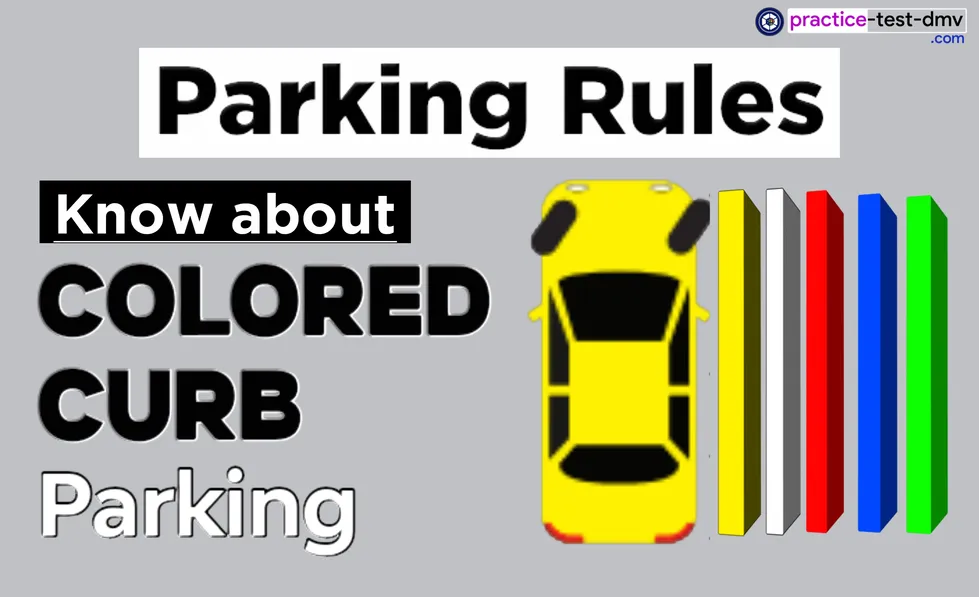Drivers in California will notice that there are many different painted colored curbs, and some drivers may still be confused as to what each of these different colors means. Let’s look at the various colors so you can learn what they mean and how they will affect your driving and curb parking.
Navigating California's city streets demands a nuanced understanding of Colored curb parking rules. This detailed guide unveils the significance behind each Colored curb - white, green, yellow, red, and blue, empowering drivers to traverse the state's roads seamlessly while adhering to California parking regulations.
California Parking Rules Unveiled
California's parking rules are as diverse as its landscapes. By deciphering the colour-coded curbs, drivers can ensure compliance and avoid unnecessary fines. Let's dive into the specifics of each Colored curb:
White Curb Parking:
Quick Stops for Passengers: Stop only long enough to pick up or drop off passengers.
White curbs are designated for swift stops related to passenger activities. Whether picking up or dropping off passengers, it's essential to understand that white curb areas are not meant for extended parking. Efficient pick-ups and drop-offs can be achieved within the confines of this curb colour, contributing to smoother traffic flow.
Green Curb Parking:
Time-Limited Convenience: Park for a limited time. The time limit may be posted on signs or painted on the curb.
Green curbs signal time-limited parking opportunities. To make the most of these spaces, drivers must pay attention to posted signs or curb markings that indicate the allowable duration. This time-limited convenience is particularly handy for those looking to run quick errands without overstaying their welcome.
Yellow Curb Parking:
Loading and Unloading Etiquette: Load and unload passengers and freight. Do not stop longer than the time posted. If you drive a noncommercial vehicle, you are usually required to stay with your vehicle.
Yellow curbs are specifically designated for loading and unloading purposes. Adhering to the posted time limits is crucial, ensuring a fair rotation of these spaces for all users. Noncommercial vehicle drivers should stay vigilant and remain with their vehicles during loading or unloading activities.
Red Curb Parking:
No Stopping, Standing, or Parking.
Red curbs signify strict no-stopping, no-standing, and no-parking zones. Respecting these areas is vital for maintaining traffic flow and allowing swift access for emergency vehicles. Drivers should exercise heightened awareness when encountering red curbs, avoiding any form of stationary activity.
Blue Curb Parking:
Accessibility Matters: Parking for a disabled person or someone driving a disabled person with a special placard or special license plate.
Blue curbs are reserved for individuals with disabilities holding special placards or license plates. These spots are exclusively designated for accessible parking, emphasising the importance of inclusion and convenience for those with mobility challenges.
What is Illegal Parking:
In addition to paying attention to the colored curbs when you are parking, you should also be aware of the other laws involving parking. Always look for signs when you park your vehicle. If you see any no parking signs, it is unlawful to park your vehicle there, even just for a few minutes.
If you leave or park your vehicle at the below given places are called illegal parking.
Never park or leave your vehicle:
• Where a No Parking sign is posted.
On a marked or unmarked crosswalk.
On a sidewalk, partially blocking a sidewalk, or in front of a driveway.
Within three feet of a sidewalk ramp for disabled persons.
In front of or on a curb that provides wheelchair access to a sidewalk.
In the crosshatched (diagonal lines) area next to a designated disabled parking space.
In a space designated for parking or fueling zero-emission vehicles, unless you are driving a zero-emission vehicle.
In a tunnel or on a bridge, unless permitted by signs.
Within 15 feet of a fire hydrant or fire station driveway.
Between a safety zone and curb.
Conclusion: Navigating California's Streets with Confidence
Mastering Colored curb parking in California is a fundamental skill for drivers navigating the state's diverse and dynamic roads. By understanding the nuances of each Colored curb, drivers can contribute to a more organised and efficient traffic system while avoiding penalties. Stay informed, adhere to the rules, and enjoy the journey through California's urban landscape with confidence. Safe travels!
If you want to know much more about Colored Curb Parking kindly checkout our this video.
FAQs: California Colored Curb Parking
1. What does a white curb mean in California?
White curbs indicate quick stops for passengers. You can pick up or drop off passengers, but extended parking is not allowed.
2. Are there time limits for parking at green curbs in California?
Yes, green curbs have limited parking time. Check the posted signs or curb markings for the specific time limit.
3. Can I park at red curbs in California?
No, red curbs mean no stopping, standing, or parking. Keep these areas clear for traffic flow and emergencies.
4. What's the purpose of yellow curbs in California?
Yellow curbs are designated for loading and unloading. Stick to the posted time limits, and if in a noncommercial vehicle, stay with your car.
5. Who can use parking spaces marked with blue curbs in California?
Blue curbs are reserved for disabled persons with special placards or license plates. If you qualify, use these spots for accessible parking.


